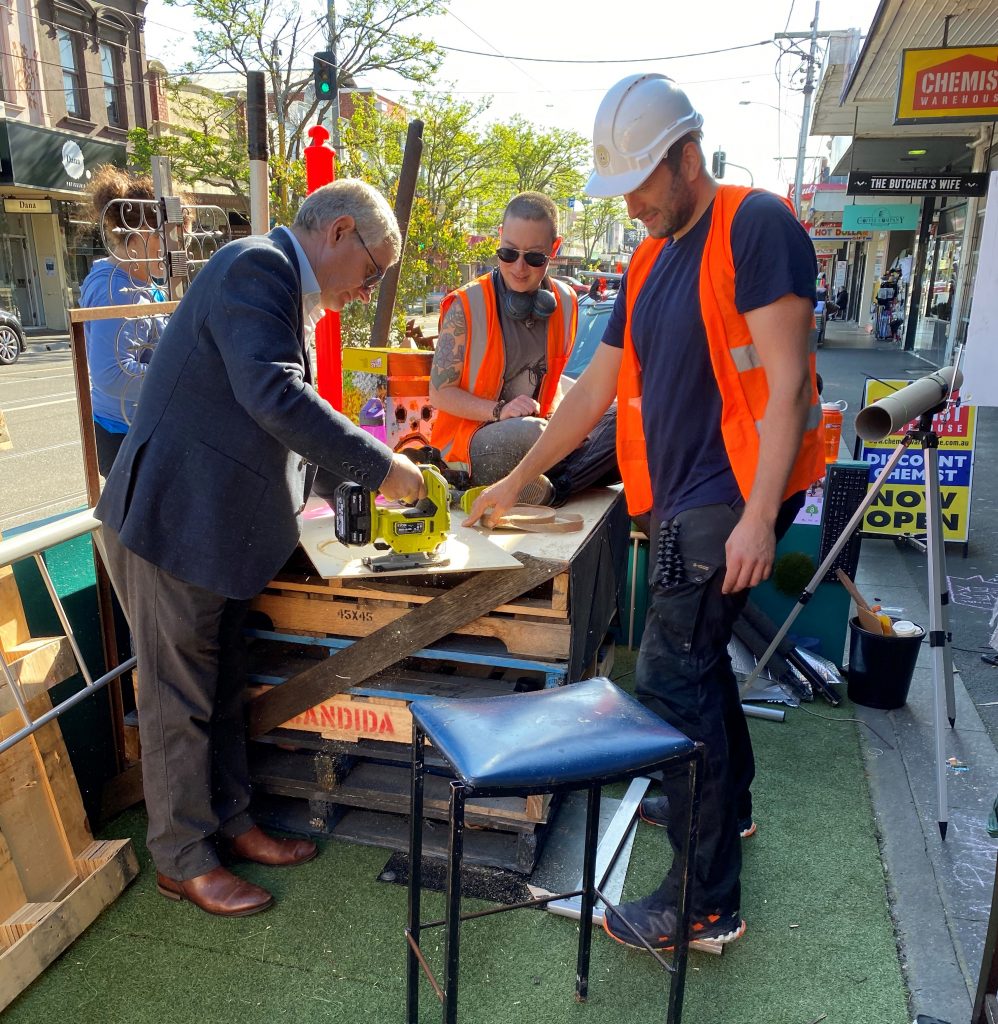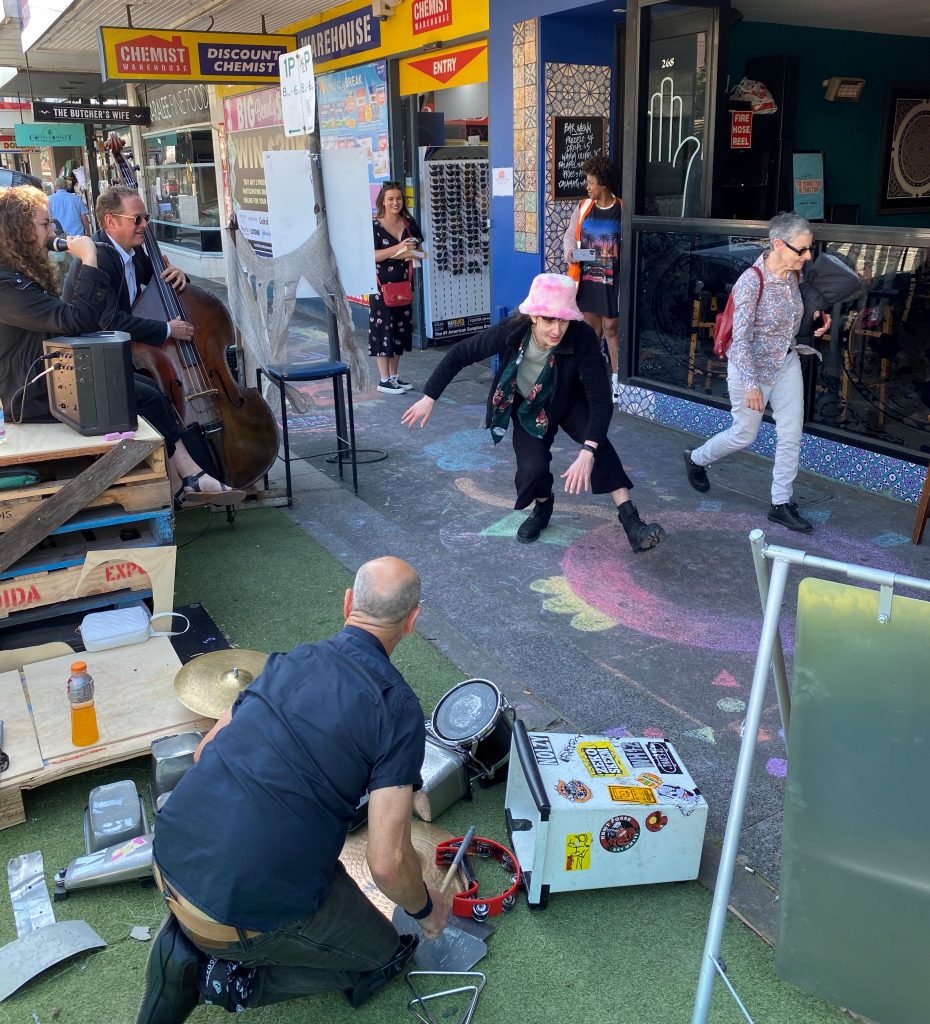
Over two days in October 2022, the Future Play Lab collaborated with Danish play activist and academic Mathias Poulsen to convert an existing, empty parklet in St Kilda, Melbourne into a pop-up skrammellegeplads or junk playground.
Originally, the plan was to bring RMIT’s playful parklet, which has travelled across Melbourne’s inner suburbs over the past year, to St Kilda. But when a nearby café expressed concern about the impact on its business, the Lab instead hired an existing parklet in front of Pause Bar that was not being used for the weekend. We then invited Poulsen to transform the parklet into a space for play, leisure and public consultation about the playful potential of parklets. This fused our interest in temporary and tactical urbanism with Poulsen’s method of designing and studying junk playgrounds as part of his PhD research at Denmark’s Design School Kolding.
For Poulsen the junk playground, or “skrammellegeplads” as it was conceived by the Danish architect C. Th. Sørensen in 1931, can be understood as an agora, a public space for playfully engaging with democratic questions. What if participation in the ongoing democratic conversations are not merely verbal, he asks, but also unfolds through playful encounters, where we build things out of discarded materials to tell stories and share our hopes and dreams with each other?
The morning began with the arrival of a truckload of junk and discarded items that Poulsen and Future Play Lab Director Troy Innocent had gathered leading up to the event: plastic and wooden crates, furniture, cloth, street signs and construction markers, wooden panels, broken sculptures, household items and a miscellany of other unidentifiable objects. Innocent also brought drills, a jigsaw and other power tools that had previously come in handy when assembling the Lab’s Clarendon Street Arcade cabinets.

Working with researchers and students from the Lab, as well as other visitors and members of the public, the team gradually constructed spaces for sitting, drawing and playing games. One table became a designated gaming area, while several wooden crates were stacked and nailed together to create a dance platform. Innocent and Poulsen also created a “reception desk” to greet passers-by, inviting them to fill out a piece of paper with a sketch of a parklet design on it to create their ideal public, playful parklet.

One challenge was that the amount of junk was too large for the parklet space, which was smaller and more confined than the Lab’s existing playful parklet. Poulsen also typically works with larger, more open spaces when running skrammellegepladsen workshops, so the parklet’s size – equivalent to a car parking space – meant there was not much room to move initially. As the day progressed, though, the team rearranged the junk into usable spaces, demonstrating that a skrammellegeplads was still possible even in such a small sliver of space.
The project also aimed to illustrate how street spaces currently dedicated for cars can quickly and easily become public spaces for community gathering, experimentation and play. The project had approval by the local council, City of Port Phillip, but the team were free to use the space for any (legal) purpose. Day 1 was dedicated to engaging with residents and preparing the parklet to become a party space for the evening.
Engagement from the public was minimal, however. The parklet was situated in front of a bar, pharmacy and organic food store close to Balaclava train station. Being in this commercial and transport hub, with only a narrow footpath between the storefronts and the parklet, most passers-by were busily on their way to shops or cafes and largely incurious about this new pop-up space in their neighborhood.
Nonetheless a few passers-by stopped to discuss the parklet and build things for it, including one man in his 50s who described himself as a professional woodworker and helped craft a racket and hoop for a makeshift ballgame; and several people who filled out the playful parklet design sheets. Workers in the nearby Little Hen food store were also friendly and accommodating.

On Day 2 playful parklet regulars Yomeciband and Communitas came to perform in and around the skrammellegepladsen. Yomeciband invites passers-by to step, jump, skip, dance or walk on chalk drawings of colourful Yomeci creatures on the footpath, generating musical sounds that are improvised on a keyboard synth and played through bluetooth speakers. Like the day before, most passers-by were on a mission and simply walked through without playing, but children in particular often stopped to dance and skip along the drawings. Two skeptical teenage boys were also unconvinced by Innocent’s explanation that the sounds were created by nanobot sensors embedded in the chalk drawings, preferring the more obvious explanation that Yomeciband sound designer Fynn Michlin created them on the fly.
Communitas allows passers-by to influence and conduct a musical performance using word cards and hand gestures that instruct singer Tanya George, singer/bassist Dan Witton and drummer Paul Guseli to slow down, speed up, freestyle, or stop altogether. It also attracted only a few dedicated participants, including several people (Michlin among them) who used interpretive dance moves that the band responded to and incorporated into the tempo and style of their performance.

The end of Day 2 saw the skrammellegepladsen dismantled and Pause Bar’s parklet revert back to an empty space. The following weekend, the Lab appropriated another space across the road – a dedicated community parklet implemented and managed by City of Port Phillip – for two more interactive and informative activations.

On Sunday 9th October the Seaweed Appreciation Society International (SASi) brought their portable seaweed library to one end of the parklet – a collection of seaweed-related books and artefacts aimed at raising environmental and artistic awareness of seaweed and marine ecologies. The collection was free to browse and attracted the interest of several passers-by, including a fisherman who described how his fishing has shifted to become increasingly sustainable and who swapped contact details with SASi for potential future collaboration.
At the other end of the parklet artist Dylan Martorell set up his Robotics Ensemble, an assembly of semi-autonomous robots powered by a solar generator that generate music and sound. Passers-by could move the various robotic instruments through a laptop and keyboard interface, or simply use instruments and objects to make sound from the installation and surrounding environment. One man in particular was particularly enthusiastic, experimenting with various instruments in and outside the parklet, and at one stage was joined by two other members of the public in a completely impromptu, collaborative performance.

The Robotics Ensemble was not without controversy, though. Its noise seemed to spark the ire of a few locals, including store owners who gave disapproving glances and a resident who the team suspected might be on her phone making a complaint. In the end no “public order” officials arrived to break up the performance, however.
These two activations represent a new phase of the “playful parklet” project. It is the first time the team have built a DIY “junk” parklet from scratch and it’s also the first time we have used existing parklet spaces rather than our travelling, customised playful parklet. This is perhaps the most “tactical” of our projects so far – repurposing existing parklets for play, responding to regulations on the fly and landing in the middle of a busy commercial district where multiple, sometimes conflicting, actors, attitudes and interests are at stake.
In the coming weeks, Communitas and Robotics Ensemble will return for encore performances at the community parklet, which is stationed in front of the pharmacy at 163 Carlisle Street, Balaclava. The full program is here.
This post was co-authored by Dale Leorke, embedded ethnographer at the Future Play Lab, and Mathias Poulsen.
